A Tale of Three ZIP Codes
The first quarter of 2014 has been a turbulent time for the Northern Virginia housing market. We have experienced struggling employment growth and a slow pace of home sales, coupled with continued increases in sales prices and very low days on market figures.
In these uncertain times, it can be difficult to evaluate the market at a regional level. A review of Northern Virginia activity at the ZIP code level comparing 2012 to 2014 can better illustrate the changing market.
THE BIG PICTURE: CONFUSION ABOUND
Market performance during the first four months of 2014 has been hard to assess. The region’s median sale price from January-April 2014 was $462,000, up only 2.7 percent from the January-April 2012 level of $450,000.
Change was uneven across the region, with some ZIP codes experiencing two-year median price increases of 25 percent or more, and some experiencing declines. While there were some pockets of strong growth—particularly the Route 7 corridor between Bailey’s Crossroads and Falls Church—change varied greatly across the region.
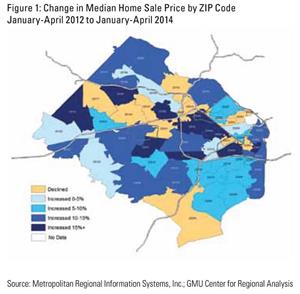 There were 11 ZIP codes in the region (Fairfax County, Falls Church and Alexandria) in which the median price increased by at least 15 percent from the first four months of 2012 through the same period in 2014 (Table 1). The character of these areas and their median prices varied greatly.
There were 11 ZIP codes in the region (Fairfax County, Falls Church and Alexandria) in which the median price increased by at least 15 percent from the first four months of 2012 through the same period in 2014 (Table 1). The character of these areas and their median prices varied greatly.
This list includes:
• Historic downtowns and urban neighborhoods (22180, 22046, 22301)
• Mixed-income suburbs undergoing rapid transformations (22044, 22041, 22304, 22151, 20191)
• Stable single-family areas in suburban locations (20151, 22032)
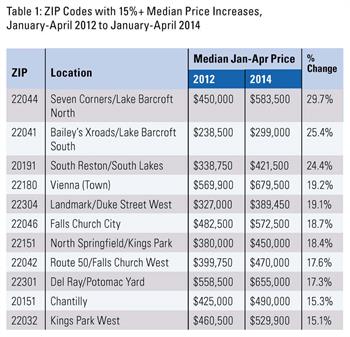
A common thread emerged among eight ZIP codes with significant declines in median sale price (>5 percent) during the period of analysis: the pace of single-family sales slowed in each area while sales of townhouses and condos accelerated. From January to April 2012, 48.4 percent of all sales in these areas were of single-family detached houses; during the same period in 2014, just 32.9 percent of sales were of single-family homes. As with the ZIP areas with strong increases, these areas include a broad range of location types.
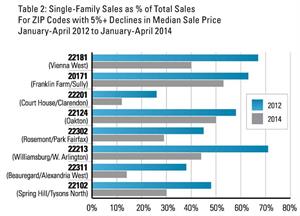
HOW ARE THESE TRENDS PLAYING OUT LOCALLY?
In order to illustrate how these countervailing forces are impacting Northern Virginia, it is helpful to take a closer look at three areas where rapid change is occurring.
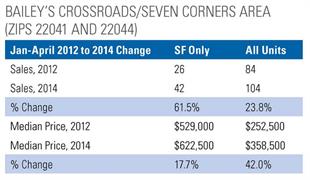 These two ZIP codes experienced the strongest increases in median price in the region, with the median sale price increasing by more than $100,000 from the first four months of 2012 to the same period in 2014. The overall pace of sales in this area increased by 24 percent during this period as well, driven by an accelerated pace of single-family sales.
These two ZIP codes experienced the strongest increases in median price in the region, with the median sale price increasing by more than $100,000 from the first four months of 2012 to the same period in 2014. The overall pace of sales in this area increased by 24 percent during this period as well, driven by an accelerated pace of single-family sales.
This area’s appeal is highlighted by the presence of Lake Barcroft; of the 16 homes that have sold for more than $1 million in this area since January 2012, 11 were immediately adjacent to the lake. The area’s close-in location and stock of small, older homes has also made it a target for luxury teardowns. There were nine sales of new homes in this area from January 2012 to April 2014; among these, the median size was 4,300 square feet and the median price was $798,000. The forces that have spurred teardowns and price appreciation should continue into the future.
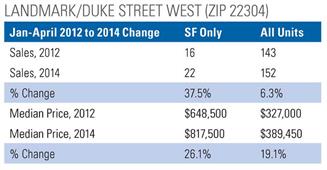 While this area has experienced an increase in single-family sales pace and prices, single-family sales still only accounted for 15 percent of sales between January and April 2014. The 19 percent price increase has been more a result of the appreciation of the area’s townhouse and condominium units, particularly in the Cameron Station development. There have been 142 townhouses sold for more than $600,000 in this ZIP code since January 2012, nearly all of which were in Cameron Station.
While this area has experienced an increase in single-family sales pace and prices, single-family sales still only accounted for 15 percent of sales between January and April 2014. The 19 percent price increase has been more a result of the appreciation of the area’s townhouse and condominium units, particularly in the Cameron Station development. There have been 142 townhouses sold for more than $600,000 in this ZIP code since January 2012, nearly all of which were in Cameron Station.
Additionally, Cameron Station was home to all but one of the 71 condo units that sold for more than $350,000 during this period. With a wave of higher-cost development planned for the areas around Landmark Mall and the Van Dorn Street Metro, this area is poised for additional growth in both activity and pricing.
 The story in this area is clear: fewer single-family sales and more townhouse and condo sales have driven down the overall median price, but prices of single-family units continue to increase. In the first four months of 2014, the median price of single-family homes in this area was $815,000, up more than $100,000 from two years prior, but the pace of single-family sales declined 20 percent. During the same period, the pace of townhouse and condo sales increased 39 percent, but the median price actually decreased because there have been more condos than townhouses sold in 2014.
The story in this area is clear: fewer single-family sales and more townhouse and condo sales have driven down the overall median price, but prices of single-family units continue to increase. In the first four months of 2014, the median price of single-family homes in this area was $815,000, up more than $100,000 from two years prior, but the pace of single-family sales declined 20 percent. During the same period, the pace of townhouse and condo sales increased 39 percent, but the median price actually decreased because there have been more condos than townhouses sold in 2014.
These patterns are not surprising: there is little room for new single-family construction and the underlying stock is generally too expensive to be ripe for teardowns. Given this area’s location near the Vienna-Fairfax Metro station and I-66, most future activity is likely to be for higher-density condo and townhouse development.
“The micro-trends at play in all three areas are a function of the limited supply of quality housing in the regional marketplace.”
SO WHAT DOES THIS MEAN?
The micro-trends at play in all three areas are a function of the limited supply of quality housing in the regional marketplace. In each area, the price of single-family housing continues to increase, with little opportunity for new single-family development aside from teardowns.
With limited single-family supply and demographic trends pointing to demand for smaller homes in walkable locations, there should be a continued shift towards townhouse and condominium development in the region. The location and quality of these developments is a critical piece.
“Town center” projects such as Cameron Station and developments around Metro stations should remain popular, while more isolated or outlying developments may struggle to perform.
Realtors® who serve clients in areas experiencing these micro-trends should explore the new multi-family developments, and be prepared to educate consumers about the change in available housing stock.
David Versel is a senior research associate with the George Mason University Center for Regional Analysis.